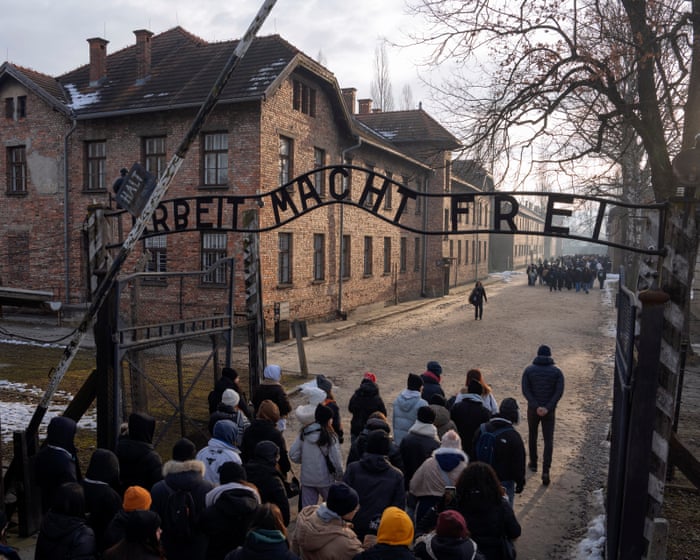The saying “a picture is worth a thousand words” may no longer hold true. With images flooding the internet at an unprecedented rate, their meaning risks being diluted—especially as AI increasingly threatens the authenticity of what we see. One might wonder why the endless stream of images showing the relentless killing and devastation in Gaza hasn’t stopped the slaughter of Palestinians.
Enter Juergen Teller, the rebellious star of 1990s fashion photography, who has now published a coffee-table book about Auschwitz, the Nazis’ concentration and extermination camp. This is a far cry from his usual work. Teller became famous for making beautiful things look ugly—a style associated with “authenticity,” grunge, and the so-called “heroin chic” that made him the most sought-after fashion photographer of his time.
Titled simply Auschwitz Birkenau, the book is published by Steidl, Germany’s leading art book publisher, with a cover designed by Peter Saville, the creative mind behind Joy Division and Factory Records’ iconic artwork.
So what’s inside? Photographically, it’s underwhelming—documenting the site as it stands today, preserved as a memorial against forgetting. The images could have come from an anonymous Flickr account. Like an overeager tourist, Teller captures everything in Oświęcim, the town where the camp is located: electronic parking signs, tacky fast-food joints, and details of the gas chambers. There’s no hierarchy to the shots, just a sense of haste. All 800+ photos were taken on an iPhone with repetitive simplicity—close-ups of barracks, then panoramas; close-ups of empty Zyklon B cans, then wider shots. The same approach applies to clichéd images like “barbed wire perspectives” and melancholic close-ups of melting snow.
Interspersed with the photos are testimonies from survivors, compiled by Christoph Heubner of the International Auschwitz Committee, who invited Teller to undertake this project. Heubner also spearheaded the Gerhard Richter Birkenau pavilion, an exhibition space that opened in Oświęcim last year.
Teller’s book caught my attention because of Heubner’s involvement. Why invite a celebrity artist—especially a German one—to document Auschwitz? The issue isn’t that Teller is famous or that his background is in fashion. The problem is that these photos add nothing to our understanding of Auschwitz. They’re utterly unremarkable, failing to achieve what new photography of the site should: drawing attention to something previously overlooked.
One could argue this was intentional—that Teller deliberately suppressed his style to make himself invisible. But he isn’t invisible. In Block 27, a barrack housing an interactive installation on nations’ experiences of extermination, there’s a “Book of Names,” inspired by Yad Vashem, listing every known Auschwitz victim. What does Teller do? He photographs every page with the surname “Teller.” Of course, countless German Jews were murdered in the Holocaust. But singling out his own name isn’t solidarity—it’s narcissism.
The Germans, as perpetrators, tightly controlled photographic evidence of the extermination, ensuring no images leaked from the death camps. This raises a crucial, ongoing question: Is photography even the right way to confront…The Holocaust poses a unique challenge for representation since no original photographic record exists. Earlier this year, the Auschwitz Memorial created a digital replica of the camp in response to growing interest from filmmakers (currently, only documentaries are allowed to be filmed there). The only known images of the extermination camps are the four Sonderkommando photos—taken secretly by Jewish prisoners and smuggled out—which inspired Gerhard Richter’s paintings now displayed at the Oświęcim pavilion.
On the pavilion’s wall, a quote from Richter reads: “Picturing things, taking a view, is what makes us human.” This provoked criticism from Jewish-German artist Leon Kahane, whose current exhibition counters Richter’s perspective with four blank canvases, mimicking Richter’s format while repeating the quote in three languages. Kahane pairs this with photos of a recent neo-Nazi rally, redirecting attention to the ongoing reality of antisemitism in Germany.
What if true humanity lies in not forming an image? Kahane’s empty canvases highlight a deeper dilemma about how to represent the Holocaust. Richter’s approach risks universalizing the evil, stripping it of its specific historical and cultural roots. Still, it at least sparks a philosophical debate.
The same cannot be said for Teller’s Auschwitz Birkenau book. His portrayal of the camp is either banal or sentimental (including photos of souvenir kitsch). At a time when Holocaust memory is increasingly politicized, his work feels detached and vague, blurring accountability while coming across as a vanity project.
Visiting Auschwitz has become an easy way for Germans and others to signal their distance from the past—to claim they’ve moved beyond antisemitism. With books like Teller’s, some may not even feel the need for that gesture. As artists and as societies, we have a duty to history. If Auschwitz becomes just an empty symbol, and we lose the ability to convey its horror, how will future generations grasp that it truly happened?
Agata Pyzik is a critic and author of Poor but Sexy: Culture Clashes in Europe East and West. She lives in Warsaw.
Do you have thoughts on this article? To submit a letter (max 300 words) for possible publication, click here.




